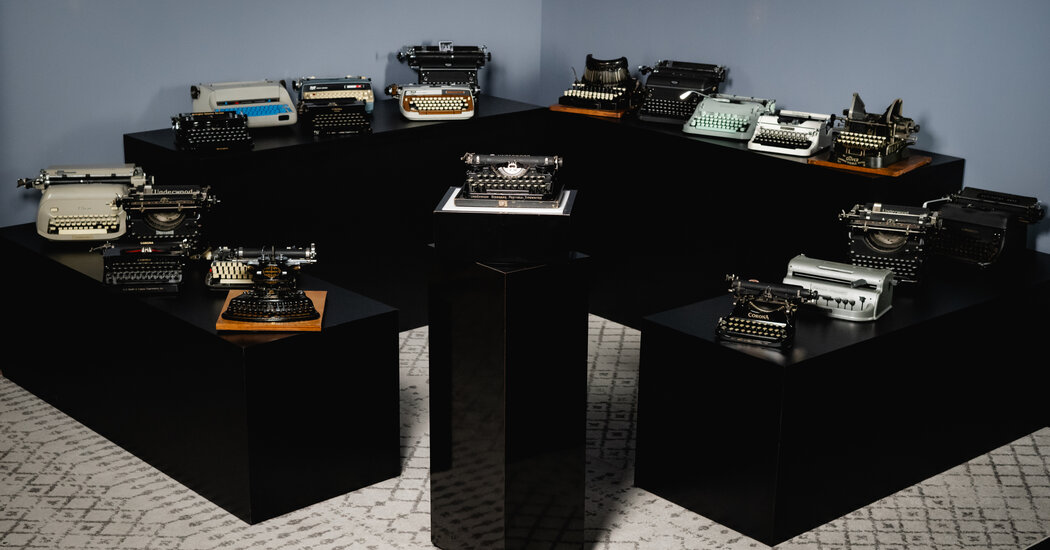You never know what can be found in a famous person’s typewriter. Joe DiMaggio’s old machine contained the cut-up shards of his expired bank card. Steve Soboroff, who bought the Yankees Hall of Famer’s typewriter in 2011, found the little pieces underneath the keys while cleaning it.
Mr. Soboroff also unearthed childhood photos of Ernest Hemingway in the writer’s 1926 Underwood Standard Portable. But Mr. Soboroff’s greatest discovery with these machines — and others, including typewriters belonging to Maya Angelou, Tennessee Williams, John Lennon and Shirley Temple — was a historical connection to great people.
“These are really hard for me to give up,” Mr. Soboroff said on a video call last week.
After 20 years of assembling what may be the greatest typewriter collection in the world, Mr. Soboroff is putting all 33 of his beloved machines up for auction. Owning them has been a privilege, he says, and each comes with a unique back story that helped fuel Mr. Soboroff’s passion.
Like when Mr. Soboroff backed out of a deal with the actress Angelina Jolie, refusing to part with Hemingway’s typewriter after she agreed to pay $250,000 for it. While reports at the time indicated Ms. Jolie was the one to walk away, Mr. Soboroff said he canceled the transaction when he learned that she intended to give the machine to her husband, Brad Pitt, for him to use. Mr. Soboroff might have allowed Mr. Pitt to bang away on Harold Robbins’s or Mae West’s machines, he said, but Hemingway’s typewriter was sacred.
“At that time, I could have used the money,” Mr. Soboroff said. “But nobody’s touching that one. Ernest Hemingway’s typewriter? No chance.”
Now someone else will get the chance to own it, because after two decades bearing the responsibility of protecting, insuring, exhibiting and shipping the typewriters all over the country to promote their legacies, Mr. Soboroff, 75, no longer has the energy for it. And he could still use the money.
Some of the proceeds will be donated to the Jim Murray Memorial Foundation, which honors the former Los Angeles Times sports columnist by issuing scholarships to journalism students. Mr. Soboroff is a lifelong fan of the Los Angeles Dodgers and revered Mr. Murray’s writing. His was the first typewriter Mr. Soboroff bought, at auction, in 2005. From there, collecting them became a devotion.
A Los Angeles-based entrepreneur and former commissioner of the Los Angeles Police Department, Mr. Soboroff bought most of the typewriters at auctions, though a few were acquired directly from family members or the previous owner.
Tom Hanks, a renowned collector himself, gave Mr. Soboroff his own Hermes 3000 after the two met and discussed their shared love of typewriters. And in 2012, not long after the journalist Andy Rooney died, Mr. Soboroff hired a Connecticut real estate agent to go to the family garage sale at Mr. Rooney’s old house and offer $5,000 for Mr. Rooney’s beloved 1929 Underwood Model 5.
The man Mr. Soboroff hired turned out to be a retired C.I.A. agent, and despite a three-hour line to get into the sale, he insinuated himself inside and secured the machine. Mr. Soboroff said that hours later, he received an offer of $125,000 from CBS, Mr. Rooney’s former employer. He turned it down.
Typewriters are imperfect little engraving machines, Mr. Soboroff likes to say, requiring more physical interaction than today’s laptops. Some exude a personality, a mechanical soul, like a vintage car or a maestro’s violin. The connection to their original owners adds to the mystique.
“They are really hard to find because some heirs don’t want to give them up,” Mr. Soboroff said. “They’ll sell the clothes, pictures. They won’t sell the typewriter.”
There is no telling yet the full value of the collection. Heritage Auctions is handling the sale, which goes to gavel Dec. 15 in Dallas, and the items will be sold separately. Last year, Mr. Soboroff donated six of his typewriters to the Smithsonian. They had belonged to John Lennon, Elia Kazan, Jerry Siegel (co-creator of Superman), Orson Welles, DiMaggio and Angelou and were appraised at an average of about $250,000 apiece.
“I shouldn’t own Maya Angelou’s typewriter,” Mr. Soboroff said. “That’s for the people of America. I shouldn’t own John Lennon’s typewriter.”
He did, however, allow Pierce Brosnan, the actor, to type on Lennon’s machine in exchange for a $5,000 donation to the Murray foundation. And he lent Siegel’s to comic book conventions, where people lined up for hours to write short notes on the same typewriter used to create Superman’s dialogue.
In making his permanent gift, Mr. Soboroff allowed the Smithsonian to choose from his collection. It passed on typewriters owned by Greta Garbo, John Updike, Philip Roth, Jack London and Gore Vidal, as well as the Braille machine owned by Andrea Bocelli. It declined the Hemingway model because it already owned one. Whoever buys this Hemingway will also get the photo negatives, the prints and the original envelopes stashed inside the case.
When Mr. Soboroff first spotted the negatives, he mistook them for ancient strips of bacon. The first one he touched turned to dust, so he scooped the rest up with a spatula and took them to a restorer, where the shots were revealed.
Sandra Spanier, an English professor at Penn State University and the editor of the Hemingway Letters Project, called the photographs a “pretty extraordinary find.”
“Finding negatives from the early 20th, when Hemingway was a small child at his family cottage, inside a typewriter, is a pretty solid link to Hemingway,” she said.
Mr. Soboroff said experts from the John F. Kennedy Presidential Library and Museum, which is home to a vast collection of Hemingway’s archives, matched the typeface to confirm it was the author’s typewriter. He said the forensic investigation showed evidence of desperate words pounded into the roller. He believes they could be some of Hemingway’s final typed thoughts, before he died by suicide in 1961.
One of the typewriters Mr. Soboroff probably won’t miss is the 1968 Montgomery Ward Signature Portable 440T owned by Ted Kaczynski, a.k.a. the Unabomber. He may have used it to write some of his manifesto before he was captured and handed four life sentences.
Mr. Soboroff bought the machine from the U.S. government, in part because the proceeds went to the victims and their families. He then wrote a letter to Mr. Kaczynski in prison on the same typewriter, asking him three questions about it. One related to the whereabouts of the carrying case, which Mr. Soboroff knew Mr. Kaczynski had used to make a bomb. Mr. Kaczynski replied — “in that creepy handwriting,” Mr. Soboroff recalled — that he would only answer the questions after verifying Mr. Soboroff’s identity.
Two months later, Mr. Soboroff received another card that read: “You are not who I thought you were. Tough luck.”
“I’m sitting at the Palm in Beverly Hills,” Mr. Soboroff said. “He’s serving 665 years in max security, and he’s saying tough luck to me? I decided I didn’t want any more prison pen pals.”
The signed correspondence is part of the sale. (Mr. Soboroff actually bought two Unabomber typewriters, but happily traded one for Ray Bradbury’s 1947 Royal KMM.) Also included in the sale are folders that Mr. Soboroff found in a 1962 Royal Empress owned by the Playboy publisher Hugh Hefner. The folders contain files, presumably Hefner’s thoughts, on topics like “Birth Control,” “Sex” and “Divorce.”
Mr. Soboroff, who was once conned into buying a fake Babe Ruth baseball card, said he now requires three methods of verification before purchasing an item. Sometimes forensic matches can be made from the imprint, like fingerprints. Sometimes there are corroborating photographs or films, like a clip of George Bernard Shaw in 1946 with his Remington Noiseless 7X from 1934, which Mr. Soboroff bought in 2008.
Mr. Soboroff has made most of the collection available for display at museums, universities and special events and asks buyers to also show the typewriters publicly. He tapped out the written requests — typos included — on his own Monarch 101 from 1937.
The machine has no delete buttons, no cut-and-paste. Just the click-clack of history.
“This is emotional for me,” he said. “I hope it will be for the people who buy them, too.”
Sumber: www.nytimes.com












